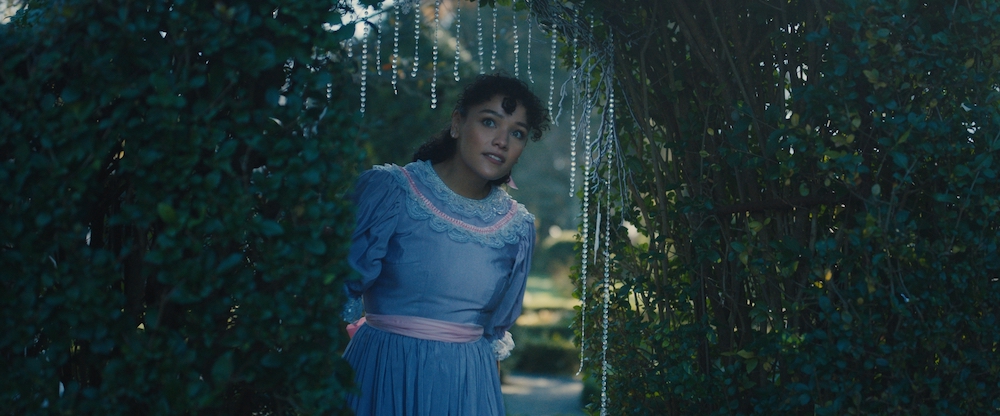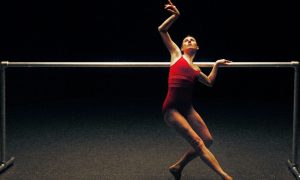December 10, 2020-January 3, 2021.
Rhode Island PBS and through an online portal on islandmovingco.org.
There’s a really special aspect of the iconic holiday tradition The Nutcracker — it’s the story of a young girl’s experience. It’s one that many renditions of the show don’t make all that explicit. Island Moving Company (IMC)’s Through Her Eyes — A Newport Nutcracker Reimagined was not one of those renditions; it intentionally centered that young girl’s experience, in a film version that was safe to create and present for dancers and audiences. The film was directed by Marta Renzi and choreographed/conceived by IMC Artistic Director Miki Ohlsen and Associate Artistic Director Danielle Genest (with additional choreography from Michael Bolger, Eva Marie Pacheco and Christine Sandorfi).
In a year making it challenging to create, the company found this unique approach — full of smaller fresh creative choices which made up that whole. Additionally, each year, the company stays committed to utilizing The Nutcracker’s potential for community outreach and broad accessibility. This year, that took place through partnerships with community actors such as Rhode Island PBS.
The Nutcracker film version aired on the network on December 18, 20 and 25, 2020, allowing people across the state to access the all-ages holiday joy and wonder that this holiday tradition offers. Another notable aspect is the half-hour length of the film, as compared to 90-minute-plus lengths of most stage versions. Considering the nature of human capacity for attention and content absorption, among other aspects, sometimes less is more. This film made that clear.
The film jumps right into Party Scene, Tess (IMC’s version of Clara, danced by Tarryn Stewart) and her friends greeting one another and then dancing. This felt like an effective choice when considering fitting the Nutcracker story into a half hour. As the characters converse and dance, the shots bring viewers in close enough to feel intimate and to get intriguing views — but also pan out enough to see the whole stage picture (photography direction from Jon Gourlay).
The Sugarplum Fairy (Brooke DiFrancesco) comes right into the party following Drosselmeyer’s entrance (Greg Tyndall) — an interesting choice, considering that the character is usually introduced in Act II, and one that also foreshadows the magic to come. Editing managed to fit in antics of boys at the party and gentle sweetness of the young girls (something Stewart brings across beautifully, such as when she cradles her Nutcracker with true tenderness).
Then the squeaks of mice are in the air, and they’re there! Tess chases them down dark stairs into a kitchen and one of them steals her Nutcracker. They throw her body and she fights back — effective and evocative fight choreography! Interspersed are shots of soldiers marching. As is true throughout the film, filmmakers used diverse spaces around Newport County well, and the shots between them flow seamlessly.
While watching, I did at first think that the battle felt long considering how certain favorite elements of the party scene, such as Kissey Doll and Harlequin, were absent. Yet, with the question of “what’s essential to move the storyline forward in a comprehensive way?,” that and similar choices made more sense to me.
The magic of the Snow Scene also feels like something not to short-shrift, however. The scene takes place in a beautiful outdoor setting with topiary, all around and dancers in white dancing all around them. The outdoor setting of the iconic scene makes it all the more magical. That moves right into the cultural divertissements, beginning with French. The aesthetic is candy cane, red and white in patterns and curved stripes. The young dancers carry hula hoops in that aesthetic, moving in and through lovely formations. They circle around as if surrounding Tess with positivity and care.
Tess explores further until she comes upon a Chinese Teahouse, and there — through a window — she sees Chinese Tea danced. The lead, Deanna Gerde, accompanied by a few other dancers, moves with lovely extensions and carriage. The choice of Tess traveling around to different locations, adventuring by her own whims and will, feels like a lovely touch. Many Nutcracker variations have her sitting and the dances happening before her. In contrast, Tess’s exploration in this film adds to the child-like wonder of the tale.
Also lovely is the aspect of “through her eyes” being more than the title; while watching, I could imagine it as if the camera view is what Clara sees as she’s watching the dancing, except in moments when she’s in the shots. That tangibilizes the idea of the Nutcracker story being one girl’s experience. Following that, Tess exploring on, Raum Aron Gens-Ostrowski and Emily Baker dance Spanish, on a deck as if on a Spanish villa. Their energy and joy brings across that Spanish flair.
Tess moves back inside into a grand space after that, and there Tara Gragg and Lauren Difede dance Arabian. They bring their rock-solid technique and dynamic performance quality to this challenging divertissement. Red/orange hand-held streamers over the camera along with the shift into the next divertissement creates a beautiful effect. Timur Kan, accompanied by dancers behind him, dances Russian Trepak with easy joy and high-flying fun.
He takes Tess’s hand and guides her toward her next location, with the Sugarplum Fairy and Cavalier (Jose Losada) there ready to dance. It hit me at that point that the Nutcracker Prince (also Tyndall) was not present after the Battle Scene. In a way, that empowers Tess; the Nutcracker Prince is just one part of the magic, one that’s so much bigger than him.
DiFrancesco has lovely lines and a serenity about how she moves, and Losada is a trusty partner with lovely lines himself. There’s a particularly memorable moment in the Grand Pas de Deux: Sugarplum comes and caresses Tess’s face, a humanizing and touching choice.
After the Grand Pas de Deux, scenes of everything that’s happened flash in between shots of Tess sleeping on a grand couch. Was it all a dream? That’s one of those fun and interesting questions with which to leave audiences, to come away with their own interpretations. That’s part of the wonder of art!
Tess awakes seeming shocked but also partful joyful because of what she just experienced, even if it was a dream. Whatever it was, it was her experience and her story. IMC brought us into that with joy, heart and technical command. What a treasure in times that can feel short on cheer and ease — brava and encora!
By Kathryn Boland of Dance Informa.















